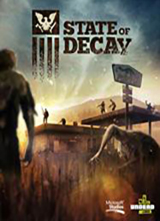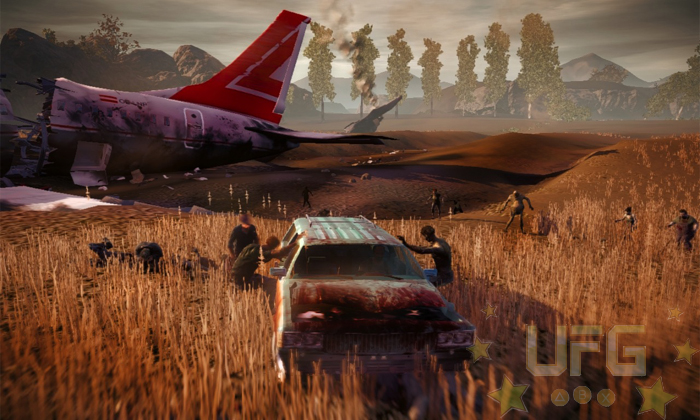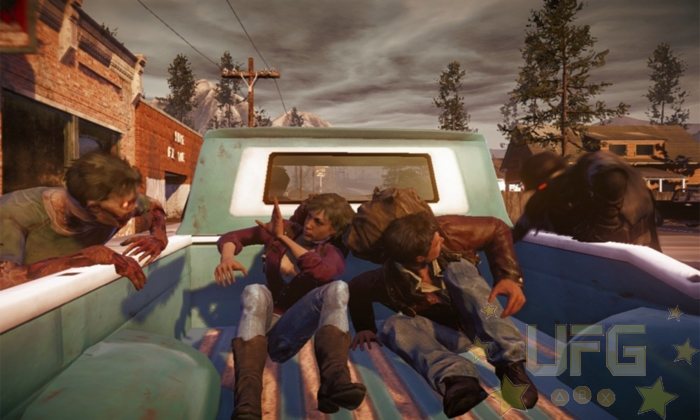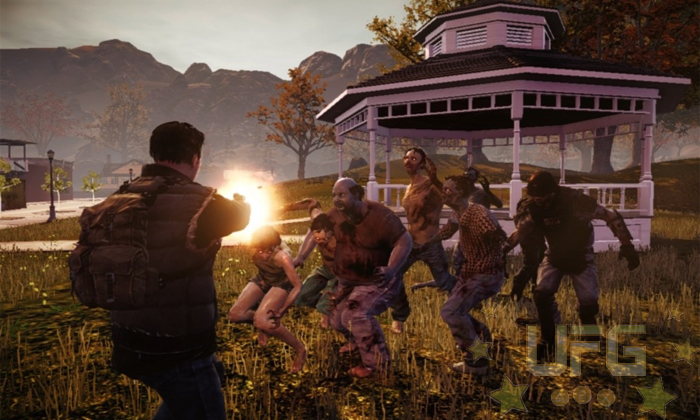State of Decay
One of the hardest things to find during this current generation of consoles was a truly next gen experience. Games that last twice as long, feature pretty graphics, and have bigger land masses are in abundance. But those things didn’t equate to what I thought the words “next generation gameplay” actually meant. The same thing goes with storytelling; awesome narratives still seem to coincide with tired gameplay mechanics from years past. Don’t get me wrong, there is a plethora of great games to play on today’s consoles. It’s just that finding a game that really pushes the boundaries of what gamers can do within a game isn’t as common as I’d like it to be.
This is one reason why I have to commend Undead Labs for what they’ve done with State of Decay. By expanding upon old survival horror elements and mixing in mechanics from other genres, they really tried to raise the bar. And although they weren’t completely successful, they still managed to create something worthwhile. The game places gamers in the shoes of Marcus, an average guy who’s been cut off from the rest of the world for a week or so on a fishing trip. When he returns to civilization he finds everything but civilized people; within seconds of his arrival he gets attacked by a group of zombies. After narrowly escaping death, he soon meets up with a group of people who are holding up in a church. This is where we are introduced to the new status quo; we aren’t at the top of the food chain anymore.
After joining the group, the game turns into a sandbox-like affair, featuring the trappings from that genre. Yes, there is a story that unravels through the process of completing missions scattered across a map. And yes, you can “steel” cars and kill “cops”. Yet, what we are presented with is much more than just a GTA clone with zombies. Undead Labs created multiple, interconnecting systems (game mechanics) that work together to give the illusion of surviving a zombie apocalypse. Take the need to salvage items, for instance. Though the threat of being eaten alive is certainly a cause for concern, it’s tempered (ironically) with the threat of starvation. One can’t just simply go to the grocery store and grab some food anymore…at least not in the way we are accustomed to. As the days go by, Marcus’s group will go through things like medicine, food, fuel, and more. In order for the group to survive, gamers will actually need to go out on raids to collect necessary items from surrounding areas. What you find is determined by where you look; you could easily find a few antibiotic or painkillers in the upstairs bathroom of an abandoned house. However, that pharmacy down the street is a much better choice for your medicinal needs.
Small items (like aspirin) can easily be collected if there is room in your backpack. The best hauls, which are more difficult to acquire, come from large groupings of supplies. Once found, you’ll be given the option of loading everything into a large bag to be carried on your back, breaking it down to its individual components or contacting a group member to come pick it up for you. Your decision will usually depend on several other factors (systems) within the game. One such factor would be your stamina. Going from house to house throughout the day will inevitably tire out your character ; their max stamina will drop. Their stamina is tied to their ability run, fight, climb…basically anything that would elicited more effort than what’s needed to walk casually. Of course, carrying a lot of stuff would exhaust your stamina quicker than if you chose to just grab a few things. And while you are still capable of defending yourself, to a degree, having low stamina puts you at greater risk of experiencing a horrible death.
Preserving your life isn’t your only responsibility; you’ll have to do your part in helping the group survive. If not, you won’t gain any “influence”, which is the game’s currency. The items you bring back to the group are stored in a community locker, of sorts, to be rationed off later. If you have the right amount of influence, you’ll be able to take the supplies you need as you see fit. Taking rare or more useful items (a gun) will require more influence over the group than something less useful (a pocket knife). The same thing goes when it comes to giving orders. Revisiting the dilemma of how to collect items from one of those large pile of goodies, telling someone to drop what they are doing to come pick it up requires influence.
Hopefully you are beginning to see how all of the game’s mechanics are interconnected. Another example has to do with the individuals that make up your group. Once you’ve made friends with a NPC, they’ll become playable. Let’s say you’ve been using Marcus and his stamina is dangerously low. Switching to another person will not only let Marcus rest (slowly regain his stamina) but also makes it easier to continue scavenging; no need to waste influence calling for help when you can go grab what the group needs as a different character. In addition to the convenience of utilizing multiple characters are some light RPG elements that help to determine the most appropriate character for a specific task. Each character has personal stats (cardio, fighting ability, marksmanship, and others) that can be improved during play. Running frequently will increase a character’s cardio, for instance. Obviously one of the benefits of being healthy is better stamina – being able to outrun a horde of zombies is always a plus.
Even if you aren’t directly controlling a character, you’ll still have to worry about them. A record of how many resources are used each day paints a picture of your group’s wellbeing. If a large amount of medical supplies are needed daily, that either means there is a lot of sick people in your group or the members aren’t able to effectively fend off attacks. While that fact is important on its own, this also means that there aren’t as many able people to go out and gather resources. You see, group members will venture out on their own and sometimes come back injured. Sometimes they may not come back at all. To help facilitate safe travel for your comrades, you can make outposts out of buildings or houses. This is usually done because a particular place has large quantities of a needed item, which can be looted multiple times. But, it also serves as a temporary safe haven; no zombies can spawn within a small area around the outpost. While not completely safe, they offer an alternative to the more dangerous houses/buildings. Other characters can choose to go to the safe-ish outposts you’ve set up, making their return to home base more probable.
Infestations will also cause people to come up missing. Infestations are houses/buildings filled with zombies that need to be cleared out. If left alone they will spawn hordes of zombies that will roam the streets, making it difficult for other characters to go collect supplies. Since they have to actually walk the streets (they just don’t pop up in places), if they run into zombies, they’ll run and hide somewhere. Eventually, you’ll be given the opportunity to go find them based on their last known whereabouts. Take too long though, and they may end up missing forever.
I love how much thought went into the concept of survival. There is always something extra to consider when making a decision on what to do. Completing supportive tasks for the group will raise influence, which gives you more control. However, not getting enough rest will cause you to grow tired. Too much fatigue puts you at risk. You can always switch to another character, but that person might not be as skilled as the person you were using before. If someone becomes missing for whatever reason, then that’s one less person to choose from. Meaning, you may be forced to rely on a character that hasn’t slept in a few days. On top of all this are the things I haven’t even mentioned yet. The group’s morale could drop; having the same people do all the work could lead to them being frustrated. A fight could break out and a gun could go off, injuring someone. Now you have a loss of ammo, a person that needs bed rest, and less friendly people (meaning you can’t play as them) to choose from.
The game can get tough when you have less people to directly control. Like I said before, a character that hasn’t slept will have low stamina and a greater risk of dying. What’s important to note about that last statement is that death is permanent. If someone dies, they are gone forever. When I lost a character that I used a lot, I could really feel the impact of her death. Not because of some deep back story, but because she was experienced. Her skills were significantly better than the other characters. Also, because I spent hours playing as her, to know that I wouldn’t be able to hear her talking amongst the rest of the group was disheartening. She wasn’t just a regular character due to the time I invested in her if that makes sense.
The difficulty in having to micromanage all of these things reinforces the idea of it being difficult to survive in this type of setting. This goes double when dealing with zombies. The undead are relentless and can take a lot of punishment, making direct confrontations a tense affair. They can latch onto your person, pull you from moving cars, and chase you through multiple houses. Being quiet and using stealth is often the best way to stay out of danger. Even when searching through things in a house, you want to take it slow. Rushing through may cause you to break something and create noises that will attract zombies. If you are forced to fight, using a melee weapon is usually the best choice as they don’t make a lot of noise. Guns on the other hand are noisy, easy making things way more difficult. When it comes to using melee weapons, unlike other games, they don’t degrade rapidly; I never understood the notion of a metal bat becoming useless after a few swings…
The only thing stopping Undead Labs from actually reaching their goals of creating an awesome survival horror game is the lack of polish. Things don’t always work as they should which causes this carefully built net of interweaving systems to crash in on itself. No matter how safe I made my surroundings, for example, people would always end up missing. I don’t mean one or two here or there. I mean, upwards of five people would be gone at a time. Worse still was the fact that time would continue to pass even after you’ve turned off the game. Apparently, if you leave your group in good standing before exiting to the main menu, then they’ll be better off when you return. To be honest, I’m not a fan of my game continuing to play while I sleep (even the Sims can be paused!), but what made me furious was the fact that it didn’t seem to matter how well I was doing. Having a surplus of supplies, working vehicles, multiple outposts, and enough guns to stop an army of zombies didn’t mean much because people kept disappearing. I even cleared out most of the infestations on the map (not just in my immediate area). These were the things that the game told me needed to be in place to keep my group alive, but I was not rewarded when I went above and beyond what it considered to be “good” enough.
Then there are the glitches. There is no need to barricade a window when a zombie can just phase through solid objects. This trick wasn’t limited to the zombies; one time I was being attacked by a zombie and was literally pushed through a wall. Now I was outside and had to fight my way back into the house I was defending. There are also graphical issues, with objects randomly popping into view whenever you’re moving quickly through the environment. It sucks trying to flee from a group of zombies in a car only to be stopped in your tracks because you ran into an invisible tree. These things aren’t as bad as poor working mechanics (a patch or two could fix the glitches), but they still hinder one’s enjoyment of SoD.
All and all, State of Decay is a good game with great ideas. The story was interesting enough, the game’s map is a decent size, and most of the mechanics work well with one another. Undead Labs worked hard to create the best zombie sandbox to play in…to survive in. They even went so far as making every structure available to explore with no loading times. The only caveat being the game’s lack of polish; the abundance of glitches and the overzealousness in some of the world’s systems will often cause frustration in players. That said, I would be lying if I said that I didn’t enjoy my time with SoD. I do recommend buying the game only with a word of caution. Hopefully a patch will be released that will address some if not all of these concerns!
Gameplay:
7
SoD is an entertaining title that’s hindered by glitches and sometimes wonky mechanics.
Graphics:
6
The game doesn’t look bad…though the pop-in can negatively affect the gameplay experience.
Sound:
8
The moans from a nearby zombie can be frightening and the voice work, although it wasn’t stellar, was also good!
What's New:
10
The way the systems were intended work together created something entirely new within this genre. I hope other developers took note of State of Decay’s successes!
Replay Value:
9
Even with the game’s issues, it’s hard not to keep playing.
Final Score:
8




